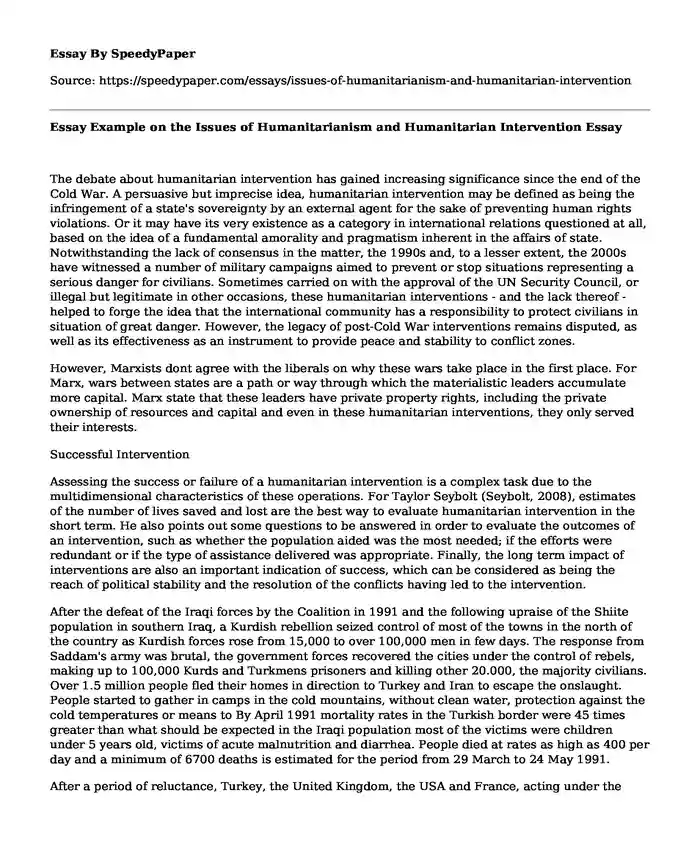
| Type of paper: | Essay |
| Categories: | International relations War Cold War |
| Pages: | 3 |
| Wordcount: | 663 words |
The debate about humanitarian intervention has gained increasing significance since the end of the Cold War. A persuasive but imprecise idea, humanitarian intervention may be defined as being the infringement of a state's sovereignty by an external agent for the sake of preventing human rights violations. Or it may have its very existence as a category in international relations questioned at all, based on the idea of a fundamental amorality and pragmatism inherent in the affairs of state. Notwithstanding the lack of consensus in the matter, the 1990s and, to a lesser extent, the 2000s have witnessed a number of military campaigns aimed to prevent or stop situations representing a serious danger for civilians. Sometimes carried on with the approval of the UN Security Council, or illegal but legitimate in other occasions, these humanitarian interventions - and the lack thereof - helped to forge the idea that the international community has a responsibility to protect civilians in situation of great danger. However, the legacy of post-Cold War interventions remains disputed, as well as its effectiveness as an instrument to provide peace and stability to conflict zones.
However, Marxists dont agree with the liberals on why these wars take place in the first place. For Marx, wars between states are a path or way through which the materialistic leaders accumulate more capital. Marx state that these leaders have private property rights, including the private ownership of resources and capital and even in these humanitarian interventions, they only served their interests.
Successful Intervention
Assessing the success or failure of a humanitarian intervention is a complex task due to the multidimensional characteristics of these operations. For Taylor Seybolt (Seybolt, 2008), estimates of the number of lives saved and lost are the best way to evaluate humanitarian intervention in the short term. He also points out some questions to be answered in order to evaluate the outcomes of an intervention, such as whether the population aided was the most needed; if the efforts were redundant or if the type of assistance delivered was appropriate. Finally, the long term impact of interventions are also an important indication of success, which can be considered as being the reach of political stability and the resolution of the conflicts having led to the intervention.
After the defeat of the Iraqi forces by the Coalition in 1991 and the following upraise of the Shiite population in southern Iraq, a Kurdish rebellion seized control of most of the towns in the north of the country as Kurdish forces rose from 15,000 to over 100,000 men in few days. The response from Saddam's army was brutal, the government forces recovered the cities under the control of rebels, making up to 100,000 Kurds and Turkmens prisoners and killing other 20.000, the majority civilians. Over 1.5 million people fled their homes in direction to Turkey and Iran to escape the onslaught. People started to gather in camps in the cold mountains, without clean water, protection against the cold temperatures or means to By April 1991 mortality rates in the Turkish border were 45 times greater than what should be expected in the Iraqi population most of the victims were children under 5 years old, victims of acute malnutrition and diarrhea. People died at rates as high as 400 per day and a minimum of 6700 deaths is estimated for the period from 29 March to 24 May 1991.
After a period of reluctance, Turkey, the United Kingdom, the USA and France, acting under the Resolution 688 of the UN Security Council, launched the first humanitarian intervention of the post-cold war era. The Operation Provide Comfort aimed to address the immediate causes of death of refugees by providing medical assistance and creating a safe heaven for Kurdish people to return to their homes. In terms of lives saved, the operation was highly successful, as over 7000 Kurdish were saved from a probable death. The immediate problems were addressed: aid was delivered, the mortality reduced and people returned to their homes. Moreover, the cooperation between military and civilian relief agencies was noteworthy and unprecedented.
Cite this page
Essay Example on the Issues of Humanitarianism and Humanitarian Intervention. (2019, Sep 24). Retrieved from https://speedypaper.net/essays/issues-of-humanitarianism-and-humanitarian-intervention
Request Removal
If you are the original author of this essay and no longer wish to have it published on the SpeedyPaper website, please click below to request its removal:
- Industrial Revolution Essay Sample
- Fundraising Issue, Free Essay for Your Inspiration
- Free Essay: Case of Anna O and the Development of Psychoanalysis
- Response Essay Example: Would Football without Concussions Still be Football?
- HRM Essay Example: What Do You Think Yahoo Is Doing?
- Free Essay: How Men and Women Have Differences in Income
- World War II Brought About the Cold War. Paper Example
Popular categories




